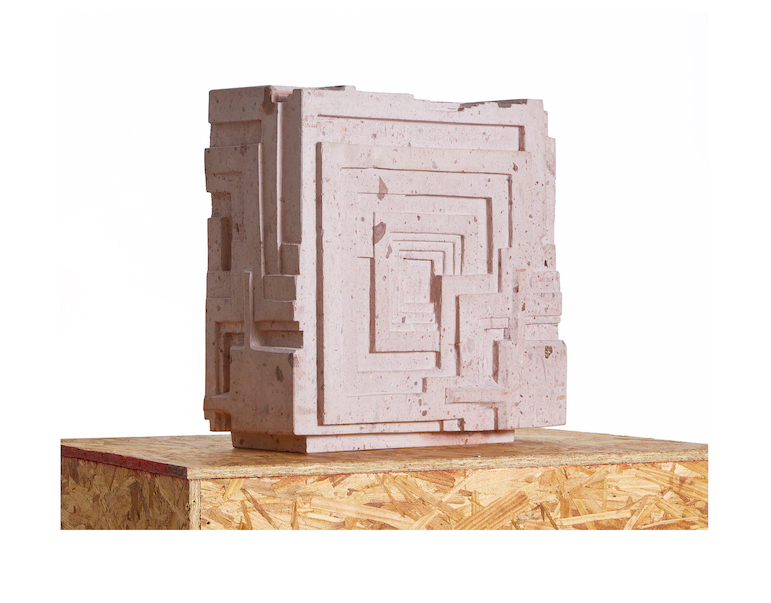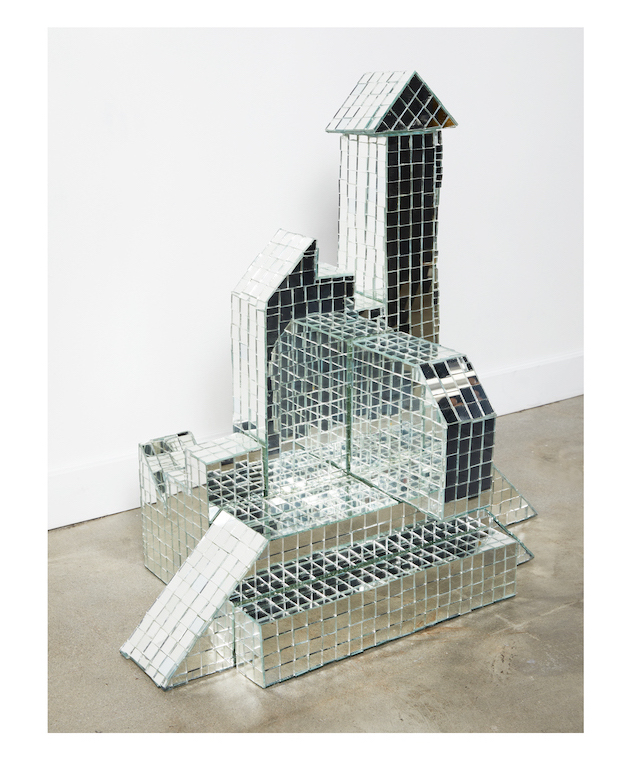For their joint exhibition at John Doe Gallery, Marek Wolfryd and Michele Lorusso present a selection of sculptures and paintings embedded in their shared exploration into Mexico’s history of architecture, urban planning and design. The title, “A Collapsing Reflection,” aptly conveys the essence of their extensive research in the past years; both artists trace the lifecycle of public buildings from inception and construction to eventual decline.
The exhibition featured new works by Wolfryd, including the cube-shaped sculpture 10th Century Retrofuturism (all works 2024). Its layered relief mirrors the textured design on the façade of Frank Lloyd Wright’s 1924 Ennis House, for which the architect employed a precast block system by mixing sand, gravel, and granite extracted directly from Los Feliz, near Griffith Park. Wolfryd, on the other hand, sourced a block of pink-colored volcanic rock native to Central Mexico and typically associated with Mayan architecture. Its mottled surface, with its linear markings etched by the artist’s tools, preserves the lost details that have eroded from ancient pre-Columbian structures built without modern machinery, but human hands.

Marek Wolfryd, 10th Century Retrofuturism, 2024. Courtesy of John Doe Gallery.
Wright’s contribution to the Mayan Revival architectural movement conjures an idyllic depiction of Mexico, perhaps more vibrantly tantalizing when compared to the country’s post-industrial towns. Documentation of the residence blurs the line between the inspired-infused decor and the original copy, complicating the task of tracing authenticity to its source. In Notes on National Anthropology, Wolfryd embarks on a similar line of research by drawing parallels between the façade of Mexico City’s National Institute of Anthropology and Victor Vasarelly’s painting series, OND. Both display a closely similar dotted pattern, suggesting a shared visual language that remains unknown, and at least unnoticed by the institution.

Michele Lorusso, Mira Blocks #2, 2024. Courtesy of John Doe Gallery.
Next to the painting, Lorusso’s sculptures titled, Mira Blocks #1 and Mira Blocks #2 offer insight into Mexico’s ongoing seismic activity and its impact on architectural design, which have resulted in an environment where buildings fall and rise. The sculptures comprise geometric Styrofoam blocks of varying dimensions, each decorated with mirror squares encrusted onto their surface. The artist stacks them together to craft architectural structures that depend on gravity’s weight for stability. Their foundation, fragile and precarious, mimics the inherent risks created by unethical construction practices aimed at maximizing profits. These practices range from disregarding building regulations to presenting false documentation and using substandard materials, all of which have historically led to mass fatalities in Mexico.
Throughout the show’s run, Lorusso will activate the sculptures by altering the arrangement of the blocks. The day that I visited the gallery, I observed him deconstruct Mira #2 and reassemble it into an entirely new sculpture, complete with a triangular ceiling and vestibule in the front, as I had imagined it. The illusion of control over a structure destined for collapse paradoxically eased, in that moment, my tendency to think catastrophically about future events, including the potential fall of the blocks. I found comfort in knowing that something new can be built from the rubble.

